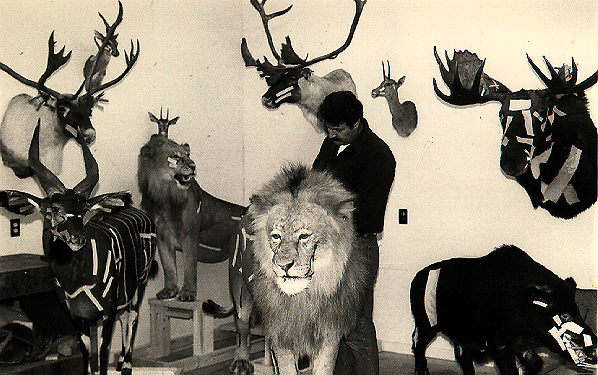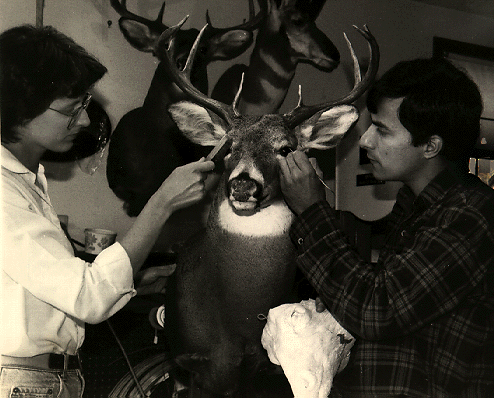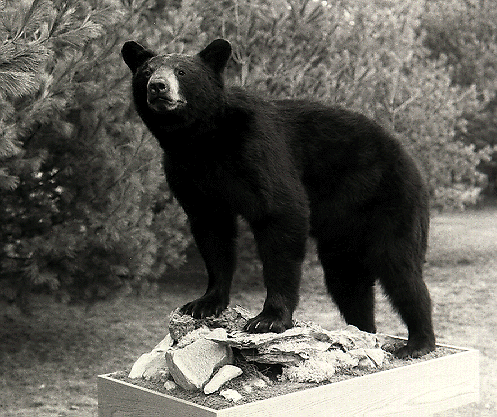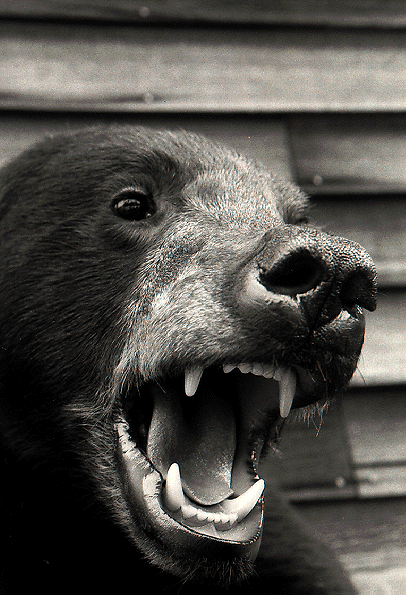|
Muzzle Blasts Online |
|
...for the muzzleloading enthusiast |
|
The muzzleblasts.com domain, subdomains, content, etc., are neither affiliated with the NMLRA nor its paper magazine Muzzle Blasts |
|
Muzzle Blasts Online |

|
|
|
|
|
|
Choosing a Taxidermist
Many hunters invest hours in planning a trophy hunting trip, investigating and selecting outfitters and guides, investing in equipment and air fares, and carefully addressing every minute detail they can think of to make sure it all goes off without a hitch and ends successfully; yet they give so little thought to selecting a taxidermist. I remember receiving a telephone call from a hunter several years ago who had just returned from a mule deer hunt out west.
"Hey, Al, I just got home from Montana; I took a nice buck and want to get it mounted. Do you know any good taxidermists?" I have had a lot of fish and game mounted over the years, so I pointed the caller in the right direction, but I found the request rather surprising. How could anyone planning a trophy hunt fail to devote thought to selecting a taxidermist? The very idea seemed alien to me. My primary reason for hunting is a love of wild game on the table and the joys and challenges that hunting brings. Not all the big-game I harvest ends up on the wall, but a good many specimens do, and I discovered long ago that selecting the right taxidermist can be the icing on the cake and make a successful hunt last a lifetime.
Unfortunately, for many people the deciding factor in selecting a taxidermist is money. Owning a mount is a luxury for most of us, and it may be difficult to justify spending several hundred dollars. Why lay out $450, for say, a whitetail head mount, when you can get it done for $250?
The answer is, you get what you pay for. I know several taxidermists here in southern Maine whose prices are miles apart. Their prices differ by about $125 right down the line on most deer-size game, and more on larger game such as moose, elk, and caribou. That may seem a bit much, but when the two products are compared, the differences are obvious. One takes pains to alter molds for a more life-like appearance, and uses higher quality, more realistic eyes and ear molds. All contribute to the product's appearance, but these and other hidden qualities contribute to how long a mount will last. Will the mount start to fall apart in just a few years, or become a family heirloom? Considerable time and effort are also given to detail around the eyes, especially the tear ducts, and the mouth and nose. One fellow is a master at providing those extra touches such as muscle texture and facial expression that make his work appear truly life-like. The other taxidermist's work is good, but what I would describe as standard or basic. Such differences are reflected in the price.
Like everything else, quality taxidermy costs money. A mount that returns with its eyes crossed or looks less than life-like is no bargain whatever the cost. While it can be said a higher price does not always guarantee a better mount, in most cases it does. When it comes to cost, look at a mount as an investment, a piece of art, because that's exactly what it is. Remember, too, the more time a taxidermist spends on fleshing and cleaning hides, splitting the lips and turning the ears before sending the project off to the tannery, and the more holes or cuts he has to mend during the mounting process, the higher your bill is apt to be. You can often save money by making sure your guide or outfitter practices proper field care, and that hides are delivered to the taxidermist free of dirt and blood stains.

|
|
One thing the author asks when checking out a new taxidermist is who does the work. |
It also pays to take someone with you who has had some taxidermy work done before, perhaps a hunting buddy or relative. This person may have a better idea what to look for. Try to evaluate the same type of animal you plan to hunt. Some taxidermists specialize in certain types of game, or have mounted certain animals more than others. They may do excellent work on whitetails, but less than acceptable work on moose or elk.
I like to compare firsthand one taxidermist's work with that of other taxidermists. This can be difficult, but I have found the best way to do it is by visiting events such as sporting shows that offer taxidermy exhibits or competitions.
When I choose a taxidermist, it's because I like his work. Price is a factor, but if the work catches my eye and I like what I see, I go on to the next step.
Ask for references and check them out as thoroughly as you do an outfitter or guide. I generally like to contact those close to home first. I find information is generally more forthcoming over the telephone than in a letter, and there is always a good chance the reference will offer an invitation for a personal look. If not, ask whether he is pleased with his mount. Was the work done as requested? Was it delivered on time? Were there any hidden costs? How long ago was it mounted, and has it held up over time? If viewing a mount in someone's home, be fair and note where the mount is hanging. If over a fireplace or in direct sunlight, any deterioration may not be the taxidermist's fault. In fact, ask the taxidermist for references several years old. This way it is possible to get an idea how his work will pass the test of time.
Terms are important as well. Prices should reflect the taxidermist's talent and experience, and quality of the finished product. Don't pay more simply because the taxidermist thinks he is worth more, unless you agree and feel the work is worth the difference.
Ask about delivery time. For the best taxidermists a year, perhaps sixteen months is normal. Some will quote slightly longer to allow time for unforeseen circumstances, but anything over a year and a half is unjustified, particularly if taxidermy is the man's full-time job. On the other hand, beware of the taxidermist promising delivery in five to eight months. Taxidermy is a seasonal business, with much of the work coming in during the fall season. Tanneries are busy at that time and through the winter, and it may take half that time to get your hide back. If delivery is promised in just a few months it could mean steps are being neglected or rushed, or the taxidermist is tanning the hide himself; you don't want either situation. He may also be quoting a fast delivery just to get your business - something else you don't want.
What about the deposit? Deposits of twenty-five to thirty-five percent are normal. Some are higher, up to fifty percent, but deposits that high have never set right with me, particularly if the delivery time is over a year. That's simply too long for someone to be using that much of my money. If the deposit is forty to fifty percent, negotiate or ask about a thirty-percent deposit followed by ten or twenty percent more when the job is half complete, and the rest upon delivery. If the taxidermist insists, use your own discretion; but I would look elsewhere even if I loved his work. To me it suggests he has more interest in your cash than in acquiring you as a client, or than in your satisfaction.
Also, if the mount is to be shipped, ask whether packing and crating are included in the price. Most times they aren't, so ask what the cost might be, and make sure that quoted price is included on your deposit or cost agreement. Also get an estimate of shipping costs. You might decide to pick up the mount personally, as I prefer to do; that saves money and ensures that the mount arrives home undamaged.

|
|
Some taxidermists work in teams. This is okay as long as both are highly skilled in their craft. |
And finally, trust your instincts. Sometimes you meet someone and something inside doesn't feel right, or a warning goes off. If a taxidermist says something that makes you uncomfortable, or his attitude doesn't set right, if he acts like you need him instead of the other way around, if he seems cold to your desires or your questions go unanswered to your satisfaction, listen to that voice inside. On the other hand, if you like what you see during your visit and the vibes are good, go with them. In life, and as a hunter, I have found those instincts rarely let you down. Chances are they won't when selecting a taxidermist.
There are several ways you can help your taxidermist to ensure you get the mount you want in a comfortable price range. To start, make sure your trophy is properly caped in the field, taking special care around the eyes, ears, nose and mouth. Make sure it is handled and preserved properly in the field, that it is packed free of dirt, twigs, and blood (to the extent possible), and that it is thoroughly salted or frozen. Make sure, too, if a head and neck or full shoulder mount is planned, that the skinner leaves plenty of cape. In any case more is always better than less.
Upon returning home, and before heading for the taxidermist, decide where the mount will be displayed. Doing so can save time by informing the taxidermist whether the head should face to the left, to the right, or straight ahead. If it's a trophy whitetail or mulie, you might want a "sneak" pose with neck outstretched and head low, or perhaps you desire a passive look, or one of alarm with the ears erect. If it is a bear and a rug is the idea, do you want the mouth open or closed? What color felt edging do you want? Bear head and shoulder mounts can also be done with closed, open or semi-open mouth. Be prepared to tell your taxidermist exactly what you want.
But be opened-minded. Ask for opinions and suggestions. Chances are if the taxidermist has been in business for any length of time he has done scores of mounts. He is the pro and may have a better idea for reasons you didn't think of.
Once you find a taxidermist with a good reputation and a happy clientele, one you feel comfortable with and have confidence in, who offers good work at a fair price and delivers on time, stick with him. Taxidermists can help you in more ways than one. Over the years my taxidermist has gone out of his way to instruct me in proper skinning and salting techniques, among other things. Once on a bear hunt in Quebec my young guide was having some difficulty skinning around the eyes. Because of what my taxidermist had taken the time to show me we got the job done. The guide learned something, and my skin arrived home properly done. Taxidermists are experts at such things, and once you develop a relationship, they are often very willing to share their tips and knowledge, particularly if it makes their job easier.
Taxidermists can also be a wealth of information in other areas, too. Because of the large number of hunters they talk to and the number of animals that come into their shop from different areas, chances are good they know where you can go for quality game. Many are also hunters themselves, are well traveled, and have contacts with reputable outfitters and guides. My taxidermist once gave me the name of an outfitter in Montana, and after taking his advice I made a booking. It was my third hunt for pronghorn and without question my best.

|
|
When a mount is complete it should appear life-like, as if it is ready to jump off the wall or walk away. Educate yourself what to look for, what is good or done poorly. |
After you visit taxidermists and make your choice, you may want to meet with that person again to make sure that he knows of your trip and the possibility that some work will be coming his way. You might discuss whether horns and skins are best shipped to him or delivered personally. You will find all kinds of things to discuss. Believe it or not, if you start your search in April or early May, by the time you make a decision and get everything ironed out it will be time to hunt.
